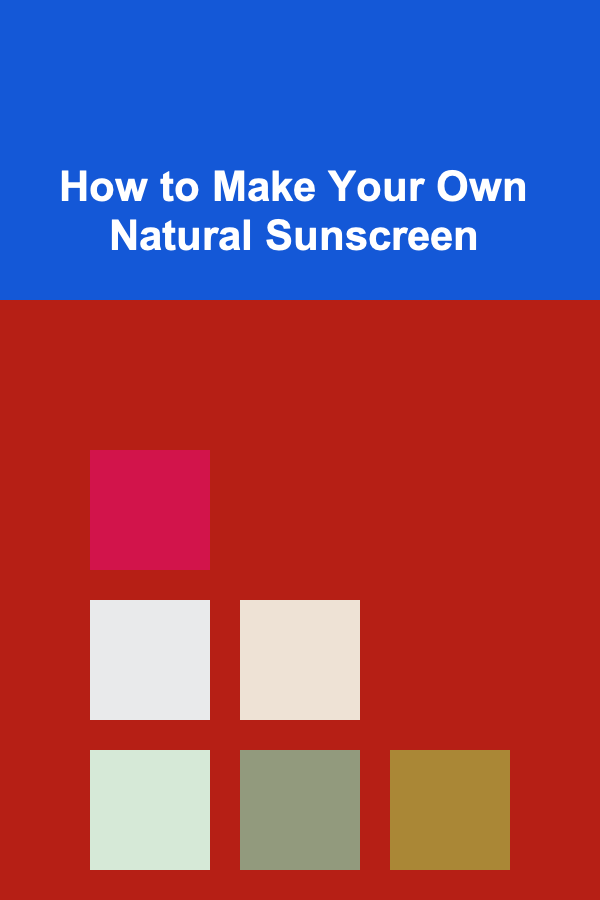
How to Make Your Own Natural Sunscreen
ebook include PDF & Audio bundle (Micro Guide)
$12.99$8.99
Limited Time Offer! Order within the next:

Sunscreen is an essential part of our skincare routine, particularly during the summer months when we spend more time outdoors. Over time, awareness about the harmful chemicals found in commercial sunscreens has grown, prompting many to seek natural alternatives. Making your own natural sunscreen allows you to have control over the ingredients that come into contact with your skin while also providing protection from harmful UV rays. This article will explore the process of creating your own natural sunscreen, the science behind sun protection, and how to choose the best ingredients for your skin type.
Why Choose Natural Sunscreen?
The decision to make your own sunscreen stems from a growing concern about the potentially harmful effects of certain chemicals in conventional sunscreens. Many commercial sunscreens contain ingredients like oxybenzone, avobenzone, and homosalate, which have been shown to have negative environmental impacts and may disrupt hormone levels in humans.
Some key reasons why people prefer to use natural sunscreens include:
- Reduced Risk of Harmful Chemicals: Many commercial sunscreens contain synthetic chemicals that may cause skin irritation, allergic reactions, or endocrine disruption.
- Environmentally Friendly: Some sunscreens contain chemicals that damage coral reefs and marine life. Natural sunscreens typically use zinc oxide or titanium dioxide, which are less harmful to aquatic ecosystems.
- Customizable for Skin Types: When you make your own sunscreen, you have the freedom to tailor the ingredients to suit your specific skin needs. You can choose oils and herbs that benefit your skin type, whether it's dry, oily, or sensitive.
- Simplicity and Transparency: DIY natural sunscreens contain only a few ingredients, making it easier to know exactly what you are putting on your skin.
Understanding UV Radiation and Sunscreen Protection
Before diving into the ingredients and methods for making natural sunscreen, it's important to understand the science behind sun protection. UV radiation, which comes from the sun, is classified into three types: UVA, UVB, and UVC. While UVC is blocked by the Earth's atmosphere, both UVA and UVB can cause damage to the skin.
- UVA Rays: These rays penetrate deeply into the skin, causing premature aging, wrinkles, and an increased risk of skin cancer. UVA radiation is present throughout the day, regardless of whether it's sunny or cloudy.
- UVB Rays: UVB rays primarily affect the outer layer of the skin, causing sunburn and contributing to skin cancer. They are stronger than UVA rays and vary in intensity throughout the day.
- SPF (Sun Protection Factor): SPF is a measure of how well a sunscreen protects against UVB rays. The higher the SPF, the more protection the sunscreen provides. For example, SPF 30 blocks about 97% of UVB rays, while SPF 50 blocks 98%.
A natural sunscreen works by physically blocking or reflecting these harmful rays, with ingredients like zinc oxide and titanium dioxide serving as physical blockers.
Essential Ingredients for Natural Sunscreen
When making your own natural sunscreen, the key ingredients will be natural oils, butters, and mineral-based sun-blocking agents. These ingredients not only provide sun protection but also offer additional skin benefits, such as moisturizing, soothing, and nourishing the skin.
1. Zinc Oxide
Zinc oxide is the primary ingredient in most natural sunscreens due to its ability to provide broad-spectrum protection from both UVA and UVB rays. Zinc oxide is a physical blocker, meaning it sits on top of the skin and reflects sunlight away from the body. Unlike chemical sunscreens, which absorb UV radiation, zinc oxide provides a non-toxic, safe barrier that doesn't penetrate the skin.
Zinc oxide is a mineral and is safe for both humans and the environment. It is often used in diaper creams, lotions, and sunscreens because it's gentle and effective. When choosing zinc oxide for your sunscreen, make sure to select non-nano zinc oxide. Nano-sized particles can potentially penetrate the skin, which may negate the benefits of using a natural sunscreen.
2. Titanium Dioxide
Titanium dioxide is another mineral-based ingredient commonly found in natural sunscreens. Like zinc oxide, titanium dioxide works as a physical sunscreen by reflecting both UVA and UVB rays. However, it is typically less opaque than zinc oxide, which means it may leave a less noticeable white cast on the skin.
Titanium dioxide also provides excellent sun protection and is less likely to cause skin irritation than some chemical sunscreens. However, it's important to choose non-nano titanium dioxide to avoid potential skin penetration.
3. Carrier Oils
Carrier oils play a key role in moisturizing and nourishing the skin while helping to spread the sunscreen evenly. These oils also contribute to the sunscreen's SPF. Some popular carrier oils for natural sunscreens include:
- Coconut Oil: Known for its hydrating properties, coconut oil also has a natural SPF of around 4-5. While it offers some protection, it is not sufficient on its own for a high-SPF sunscreen.
- Jojoba Oil: Jojoba oil is similar to the natural oils found in human skin, making it an excellent choice for all skin types. It has mild SPF properties and can help balance oil production.
- Avocado Oil: This rich oil is packed with vitamins and has a natural SPF of around 4-15. It's a good choice for dry or sensitive skin, as it provides deep hydration.
- Argan Oil: Argan oil is high in antioxidants and fatty acids, making it ideal for nourishing the skin. It also has some natural SPF properties, although it's not a substitute for mineral blockers.
4. Butters
Natural butters are fantastic for moisturizing the skin while also providing additional sun protection. Some common butters used in natural sunscreen formulations include:
- Shea Butter: Shea butter is rich in vitamins A, E, and F, and it has a natural SPF of about 6. It's great for dry or sensitive skin, as it helps to heal and protect.
- Cocoa Butter: Like shea butter, cocoa butter is hydrating and soothing. It can also offer mild sun protection, though it should be paired with other ingredients for effective SPF.
5. Essential Oils
Essential oils are often added to sunscreen formulations for their pleasant fragrance and additional skin benefits. While they do not contribute significantly to SPF, they can enhance the effectiveness of the sunscreen by providing antimicrobial, antioxidant, or anti-inflammatory properties. Some essential oils that are beneficial for skincare include:
- Carrot Seed Oil: Known for its antioxidant properties, carrot seed oil helps protect the skin and may provide additional sun protection.
- Lavender Oil: Lavender oil has soothing and calming properties, making it ideal for sensitive skin after sun exposure.
- Tea Tree Oil: Tea tree oil has antiseptic qualities and can help reduce skin irritation caused by sunburn.
6. Beeswax
Beeswax is often added to natural sunscreen recipes to help create a water-resistant formula. It also gives the sunscreen a thicker, cream-like texture and helps to lock in moisture. Beeswax is a natural emollient that can provide a protective barrier for the skin, preventing moisture loss.
How to Make Your Own Natural Sunscreen
Creating your own natural sunscreen at home is a simple and rewarding process. Below is a basic recipe to make a homemade sunscreen:
Ingredients:
- 1/4 cup coconut oil
- 1/4 cup shea butter
- 1/4 cup non-nano zinc oxide powder
- 1 tablespoon beeswax pellets
- 10-20 drops of essential oil (optional, e.g., carrot seed oil or lavender oil)
- 1 tablespoon avocado oil (or any other preferred carrier oil)
Instructions:
- Melt the Ingredients: In a double boiler or heatproof bowl, combine the coconut oil, shea butter, and beeswax. Heat gently over low to medium heat until everything is melted, stirring occasionally.
- Add the Zinc Oxide: Once the oils and beeswax have melted, remove the mixture from the heat and allow it to cool slightly. Add the non-nano zinc oxide powder and mix thoroughly. Be cautious not to inhale the powder, as it can irritate your respiratory system. Stir until the zinc oxide is completely incorporated into the mixture.
- Add Essential Oils: If using essential oils, add them to the mixture now and stir well. Essential oils not only add fragrance but also provide skin benefits, such as antioxidant or anti-inflammatory properties.
- Pour and Set: Pour the mixture into a container, such as a glass jar or an empty sunscreen bottle. Allow it to cool and set for several hours before using.
- Storage: Store your homemade sunscreen in a cool, dry place. Since there are no preservatives, it's best to use it within 3-6 months.
Application Tips:
- Apply generously and evenly on all exposed skin at least 15 minutes before sun exposure.
- Reapply every two hours or after swimming, sweating, or towel-drying.
- Be mindful of the white cast that may be left on your skin, particularly if using zinc oxide. This is a normal feature of natural sunscreens and can be less noticeable after rubbing in thoroughly.
Conclusion
Making your own natural sunscreen is an empowering way to take control of your skincare and reduce your exposure to harmful chemicals. By using simple, natural ingredients like zinc oxide, coconut oil, and shea butter, you can create a sunscreen that offers broad-spectrum protection while nourishing your skin. Whether you're looking to avoid toxic chemicals, protect the environment, or customize a formula that suits your skin type, making your own sunscreen is a fulfilling and sustainable choice.

How to Clean Your Home's Air Vents and Improve Air Quality
Read More
How to Maintain Your Roof for Longevity
Read More
How to Make Your Bathroom Look and Feel Luxurious
Read More
How to Organize Your Fitness Challenges and Goals
Read More
How to Save Big with Thrifty Gift-Giving Ideas This Holiday Season
Read More
How to Improve Your Writing Speed with ChatGPT
Read MoreOther Products

How to Clean Your Home's Air Vents and Improve Air Quality
Read More
How to Maintain Your Roof for Longevity
Read More
How to Make Your Bathroom Look and Feel Luxurious
Read More
How to Organize Your Fitness Challenges and Goals
Read More
How to Save Big with Thrifty Gift-Giving Ideas This Holiday Season
Read More